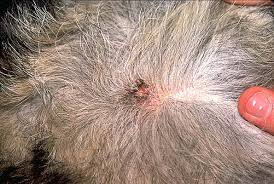Nail-like Growths on Dogs
www.cuteness.com
(This is a great website - one of those not to be missed and signing up for their newsletter is a must - great articles!)
www.cuteness.com
(This is a great website - one of those not to be missed and signing up for their newsletter is a must - great articles!)

If you're petting your dog and feel something hard that looks like a nail or horn, don't panic. These benign tumors, known as cornifying epitheliomas, might look unsightly but usually don't cause problems in the affected canine. Take your dog to the vet for a definitive diagnosis and possible treatment options.
Cornifying EpitheliomasAlso known as canine keratoacanthomas or infundibular keratinizing acanthomas, cornifying epitheliomas start in the dog's hair follicle, not his skin per se. They consist of keratin, a protein found in skin and hair. These growths vary in size and may be accompanied by some hair loss around the area. Unlike some benign growths, they will not go away on their own. It is possible for the growth to rupture, which releases keratin and other cystic material onto the dog's coat and skin and requires veterinary attention.
Affected Breeds
While any dog might develop these horn-like growths, the condition is more common in males and certain breeds. These include the keeshond, Norwegian elkhound, Old English sheepdog, German shepherd, collie, Pekingese, Lhasa apso, Yorkshire terrier, Belgian sheepdog and bearded collie. The Lhasa apso and Norwegian elkhound are at risk of developing multiple growths, according to the Merck Manual, Pet Health Edition.
Growth Locations
Cornifying epitheliomas generally appear on a dog's tail, chest, back or legs. They also might develop on a dog's footpads, so that they truly resemble an extra nail growing in the wrong place. If on the footpad, the growth may or may not cause difficulty walking. If the growth isn't bothering your dog's foot, you can trim it every time you trim your dog's nails. If the growth affects your dog's movement, your vet can surgically excise it.
Surgical RemovalIn most cases, removal of a cutaneous horn isn't necessary, except for cosmetic purposes. However, if the growth is within reach of your dog's mouth, he might chew or lick it frequently, causing wounds to form. He also could scratch it enough to result in lesions. Your vet can remove the growth, but there's always a chance new growths could develop. Your vet can prescribe retinoids, given orally, to eradicate the growths without the need for surgery.
Cornifying EpitheliomasAlso known as canine keratoacanthomas or infundibular keratinizing acanthomas, cornifying epitheliomas start in the dog's hair follicle, not his skin per se. They consist of keratin, a protein found in skin and hair. These growths vary in size and may be accompanied by some hair loss around the area. Unlike some benign growths, they will not go away on their own. It is possible for the growth to rupture, which releases keratin and other cystic material onto the dog's coat and skin and requires veterinary attention.
Affected Breeds
While any dog might develop these horn-like growths, the condition is more common in males and certain breeds. These include the keeshond, Norwegian elkhound, Old English sheepdog, German shepherd, collie, Pekingese, Lhasa apso, Yorkshire terrier, Belgian sheepdog and bearded collie. The Lhasa apso and Norwegian elkhound are at risk of developing multiple growths, according to the Merck Manual, Pet Health Edition.
Growth Locations
Cornifying epitheliomas generally appear on a dog's tail, chest, back or legs. They also might develop on a dog's footpads, so that they truly resemble an extra nail growing in the wrong place. If on the footpad, the growth may or may not cause difficulty walking. If the growth isn't bothering your dog's foot, you can trim it every time you trim your dog's nails. If the growth affects your dog's movement, your vet can surgically excise it.
Surgical RemovalIn most cases, removal of a cutaneous horn isn't necessary, except for cosmetic purposes. However, if the growth is within reach of your dog's mouth, he might chew or lick it frequently, causing wounds to form. He also could scratch it enough to result in lesions. Your vet can remove the growth, but there's always a chance new growths could develop. Your vet can prescribe retinoids, given orally, to eradicate the growths without the need for surgery.
|
What is "SOCIALIZATION"? It may not be what you think! Find out more about what you should be looking at when it comes to socialization - a critical stage in your pups development
|
Is there a difference between a designer dog and a hybrid dog? This sounds confusing, but it actually isn't.
|
To err about canines is human - some common mis-conceptions about dogs
I've listed a few of the common misconceptions or errors-in-thinking about dogs that I've run into in my years as a pet dog trainer: |





